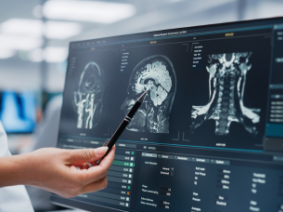What Is a Craniotomy?
Craniotomy is a procedure in which a portion of the skull (bone flap) is temporarily removed to access the brain. This allows surgeons to focus on a specific section of the brain, minimizing disruption to surrounding tissues. It also reduces recovery time and lowers the risk of complications.
What Does Craniotomy Treat?
Any condition that requires direct access to the brain for treatment can be managed with a craniotomy. These include:
- Brain tumors
- Hematomas
- Parkinson’s disease
- Intracerebral aneurysms
- Brain abscesses
- Arteriovenous malformations (AVMs)
- Severe head injuries
Types of Craniotomy
Craniotomies can be classified based on the location of the skull opening and the part of the brain being accessed. Common types include:
- Burr hole (trepanation): A small, round opening is made in the skull to relieve pressure from fluid buildup or drain blood clots; it is less invasive than a full craniotomy.
- Extended bifrontal craniotomy: Bone flap is removed from the left and right sides of the frontal part of the skull. This provides a wide access to the frontal lobes and areas at the base of the brain. Surgeons often use it for conditions that require a broader view, such as large tumors.
- Keyhole craniotomy: This is a minimally invasive approach where surgeons make a smaller opening in the skull to remove tumors. The hole can be made anywhere in the skull, including behind the hairline, near the eyebrow, behind the ears or at the base of the skull.
- Orbitozygomatic craniotomy: This type of craniotomy involves removing a larger section of bone from above the cheek to create a wider opening. It is ideal for large or complex tumors that cannot be reached through less invasive approaches.
- Supraorbital craniotomy (eyebrow craniotomy): A small opening within the eyebrow is made to provide access to the front of the brain and areas at the skull base. This technique is commonly used to treat pituitary tumors.
- Translabyrinthine craniotomy: The surgeon makes an opening through the inner ear structures to access and remove tumors located on the balance and hearing nerves, such as acoustic neuromas. Since the procedure passes through the inner ear, it results in complete hearing loss on the affected side. However, it gives surgeons a clear view of both the tumor and the facial nerve, allowing them to safely remove the growth while minimizing the risk of nerve damage.
How Is a Craniotomy Performed?
Most craniotomies are performed under general anesthesia, meaning the patient is asleep. The head is also affixed by a frame to keep it still.
The surgeon will first make an incision in the scalp and move the skin and muscles aside to reach the skull. Small openings (burr holes) are then created, and a special surgical tool called a craniotome is used to remove the bone flap and expose the dura mater, which is a protective covering of the brain. Thereafter, the dura mater is opened to access the brain.
Once the procedure on the brain is completed, the bone flap is replaced and then secured with screws. The scalp is also closed with sutures.
How Long Does a Craniotomy Take?
The length of a craniotomy surgery depends on the condition being treated and the area of the brain involved. On average, most craniotomies take three to five hours, while more complex procedures can last up to eight hours or more.
Recovery From Craniotomy
After the procedure, patients usually spend time in the intensive care unit (ICU) so doctors can closely monitor brain function and other vital signs. Once stable, they are moved to a regular hospital room.
The hospital stay depends on how the body responds. You will be encouraged to get up and move around when it feels comfortable. This will help improve circulation and lower the risk of blood clots. Sometimes, compression devices may be placed on your legs to prevent the formation of blood clots.
After discharge, it is important to keep your incision clean and dry. You can slowly increase your physical activity during this period, but avoid heavy lifting or strenuous exercise until your doctor clears you.
It is also important to watch for possible signs of infection or complications, such as:
- Excessive sleepiness
- Confusion
- Fever
- Chills
- Trouble breathing
- Seizures
- Difficulty speaking
- Vision changes
- Increased pain, redness, or irritation at the incision site
Full recovery can take a few months. However, this depends on how well you follow post-op care instructions.
Where to Get a Craniotomy
At Neurosurgical Associates of Central Jersey, P.A., our skilled neurosurgeons specialize in advanced brain surgery procedures, including craniotomies. We use the latest technology and techniques to ensure precision, safety and the best possible outcomes for our patients. If you or a loved one may need a craniotomy, schedule a consultation with our team at our Bridgewater, NJ office to learn more about your treatment options.



